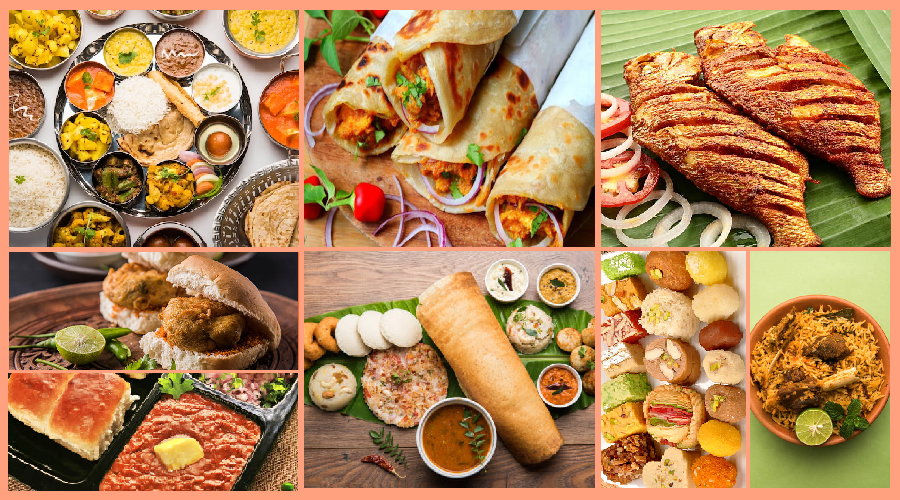India is a beautiful country well-known for its diverse cultures and rich history, offering a culinary experience for everyone visiting here. Indian food, which encompasses a staggering array of flavors, ingredients, and cooking methods, is a remarkable way to the colorful legacy of our country's heritage. With a strong emphasis on using local produce and age-old recipes, food plays an integral role in Indian culture, reflecting its many regional shade. In this article, you will enjoy a fantastic voyage through India, exploring its yummy gems and must-try dishes that make the most favorite nation a food lover's paradise - the Taste of India.
Regional Cuisine Highlights from the Taste of India
North Indian Cuisine
Popular dishes and flavors
North Indian cuisine is famous for its unique hearty flavors, amazing aromatic spices, and extensive use of dairy products. The region's most iconic dishes include butter chicken, biryani, chole bhature, and parathas. The mouth-watering flavors of North Indian cuisine are due to the use of aromatic rich gravies and collection of spices, like cumin, coriander, and garam masala.
Must-try restaurants and street food spots
Karim's, Delhi :For an authentic Old Delhi experience, head to Karim's for their legendary kebabs and nihari.
Paranthe Wali Gali, Delhi:This iconic street in Old Delhi is famous for its wide variety of stuffed parathas.
Kesar Da Dhaba, Amritsar:Visit this iconic eatery to indulge in delicious Amritsari kulchas and creamy dal makhani.
South Indian Cuisine
Popular dishes and flavors
The key ingredients in South Indian food are rice, lentils, and coconut. Dosa, idli, vada, and sambar are a few of this region's most well-known delicious dishes.
South Indian food is typically lighter and spicier than its northern counterpart, with generous use of tamarind, curry leaves, and mustard seeds.
Must-try restaurants and street food spots
Mavalli Tiffin Room (MTR), Bengaluru: A legendary establishment serving iconic South Indian dishes like masala dosa and rava idli is popluar.
Murugan Idli Shop, Chennai: Known for its soft and fluffy idlis, this is a must-visit spot for breakfast in Chennai.
Guntur Sannam, Hyderabad: A street food paradise, Guntur Sannam is famous for its fiery Andhra-style biryani and spicy curries.
East Indian Cuisine
Popular dishes and flavors
East Indian cuisine is a delightful blend of flavors from Bengal, Odisha, and the northeastern states. Famous for its delicate balance of sweet and spicy, East Indian dishes often feature fish, rice, and mustard oil. Some must-try dishes include macher jhol (fish curry), Sandesh (a sweet made from milk), and pitha (rice cakes).
Must-try restaurants and street food spots
6 Ballygunge Place, Kolkata: A fine dining establishment known for its Bengali delicacies like kosha mangsho (mutton curry) and chingri malai curry (prawns in coconut milk).
Nizam's, Kolkata: Head to Nizam's for their iconic kathi rolls, a popular street food snack in Kolkata.
Rosogolla Bhawan, Bhubaneswar: Visit this sweet shop to taste the authentic Odia rosogolla, a soft and spongy dessert made from fresh chhena.
West Indian Cuisine
Popular dishes and flavors
A rich fusion of flavors from Maharashtra, Gujarat, Rajasthan, and Goa may be found in West Indian cuisine.
From Goa's spicy seafood to Gujarat's vegetarian delights, this region offers a diverse array of dishes. Some popular West Indian dishes include pav bhaji, dhokla, and Goan fish curry. The use of coconut, kokum, and a variety of spices like black mustard seeds and asafoetida give West Indian cuisine its distinct aroma and taste.
Must-try restaurants and street food spots
Swati Snacks, Mumbai: A popular eatery known for its Gujarati snacks like panki, patra, and sev puri.
Vinay Health Home, Mumbai: This iconic establishment serves mouthwatering pav bhaji and other Maharashtrian street food favorites like vada pav, bhajji pav, etc.
Gunpowder, Panaji: Visit this Goan restaurant for a taste of authentic Goan fish curry, pork vindaloo, and other coastal delicacies.
Indian Food Festivals and Events
Overview of major food events throughout the year
- National Street Food Festival, Delhi: An annual event showcasing the best street food from across the country.
- Kolkata Food and Cultural Festival: In this festival, you can enjoy amazing Bengali cuisine, art, and music all under a single roof. It is organized every year in Kolkata.
- Sattvik Food Festival, Ahmedabad: A unique event promoting healthy, vegetarian food and sustainable living practices.
- Goan Carnival: A colorful, week-long celebration featuring Goan food, music, and dance, held annually in the month of February.
- Mango Festival, Delhi: A summer event celebrating the king of fruits, with a variety of mangoes from all over India on display and available for tasting.
Tips for attending and enjoying the festivals
Plan ahead: Research the dates, venues, and specific events of the food festivals you're interested in attending. This will aid you in having a wonderful experience and craft the most of your valuable time.
Arrive early: Popular events tend to get crowded, so arriving early can help you secure a good spot and avoid long lines.
Be open to new flavors: Food festivals are perfect for exploring new dishes and flavors. Be courageous and try something you've never tried a taste.
Be hydrated: don't forget to drink water while enjoying good food and excitement.
Dress comfortably: Opt for comfortable, weather-appropriate clothing and footwear, as you'll likely be on your feet for extended periods.
Indian Cooking Classes and Workshops
Recommendations for immersive culinary experiences
- Saffron Palate, Delhi: A hands-on cooking class that teaches you to prepare traditional North Indian dishes, followed by a meal with your fellow participants.
- Nimmy Paul's Cooking School, Kochi: Learn to cook authentic Keralan cuisine in the home of an experienced local cook, with personalized attention and guidance..
- Siolim Cooking School, Goa: Discover the secrets of Goan cuisine in a relaxed, picturesque setting, and enjoy a delicious meal prepared with your newfound skills..
- Aakriti Eco Homestay, Darjeeling: Immerse yourself in the culinary heritage of the Eastern Himalayas, learning to cook traditional Nepali and Tibetan dishes using organic, locally-sourced ingredients..
Benefits of learning traditional cooking techniques
- Cultural appreciation: Learning to cook traditional dishes helps you gain a deeper understanding and appreciation for the local culture and history.
- Skill development: Mastering new cooking techniques and working with unfamiliar ingredients can improve your culinary skills and knowledge.
- Health benefits:: you can enjoy the health benefits of fresh, local ingredients by using them as per your liking and your body type.
- Social connections: Attending cooking classes and workshops can be a fun and interactive way to meet fellow food enthusiasts and make new friends.
Etiquette and Tips for Enjoying Indian Cuisine
Local dining customs and practices
- Eating with your hands: In many parts of India, people love to eat with their right hand using their fingers.
- Sharing food: Indian meals are often served family-style, with dishes placed in the centre of the table for everyone to share.
- Finishing your plate: It is considered respectful to finish all the food on your plate, as wasting food is frowned upon in Indian culture.
Navigating street food and hygiene considerations
- Choose popular vendors: Opt for street food vendors with a steady flow of customers, as this is usually a good indicator of quality and freshness.
- Observe cleanliness: Take note of the vendor's hygiene practices, such as whether they wear gloves or have a clean workstation.
- Stick to cooked food: To minimize the risk of foodborne illness, opt for hot, cooked dishes over raw or cold items.
Ordering and understanding the menu
- Ask for recommendations: to enjoy the best dish, you can take the help of staff for their suggestions to get their best dishes.
- Know your spice tolerance: Indian food can be quite spicy, so be sure to communicate your preferred spice level to the server when ordering.
- Learn popular terminology: To understand the food at an Indian restaurant, become familiar with terms like "tandoori" (oven-baked), "masala" (spiced), and "korma" (creamy curry).
Explore the taste of India by enjoying the various tastes, customs, and history that make Indian cuisine so distinctive and alluring allows you to go on a culinary journey through India. From regional specialties and iconic dishes to street food, food festivals, and cooking classes, there is no shortage of gastronomic experiences to be had. You can immerse yourself in the rich mosaic of Indian food culture and make incredible memories by being aware of the customs and navigating the gastronomic environment with awareness. So, pack your appetite and set off on a foodie tour "Taste of India" that promises to awaken your senses and leave you craving more of India's culinary delights.





